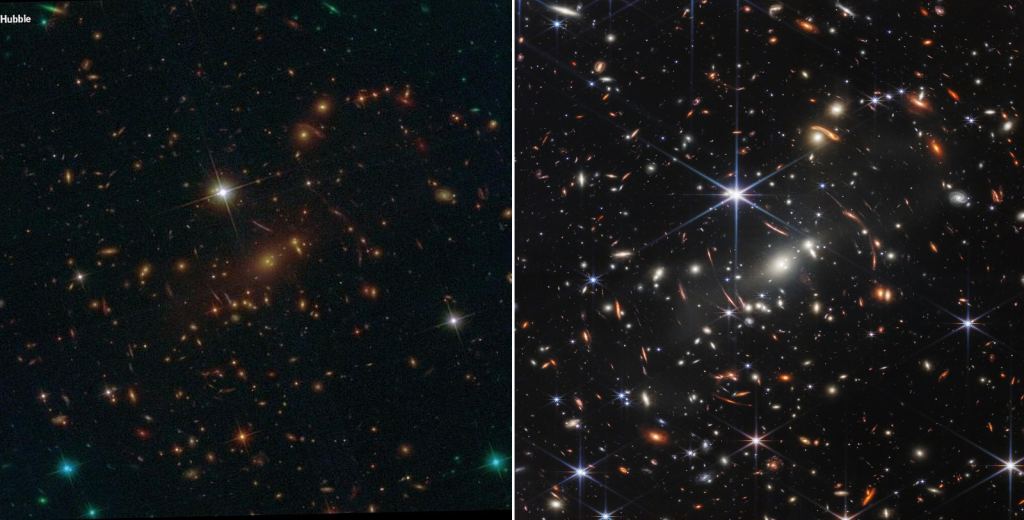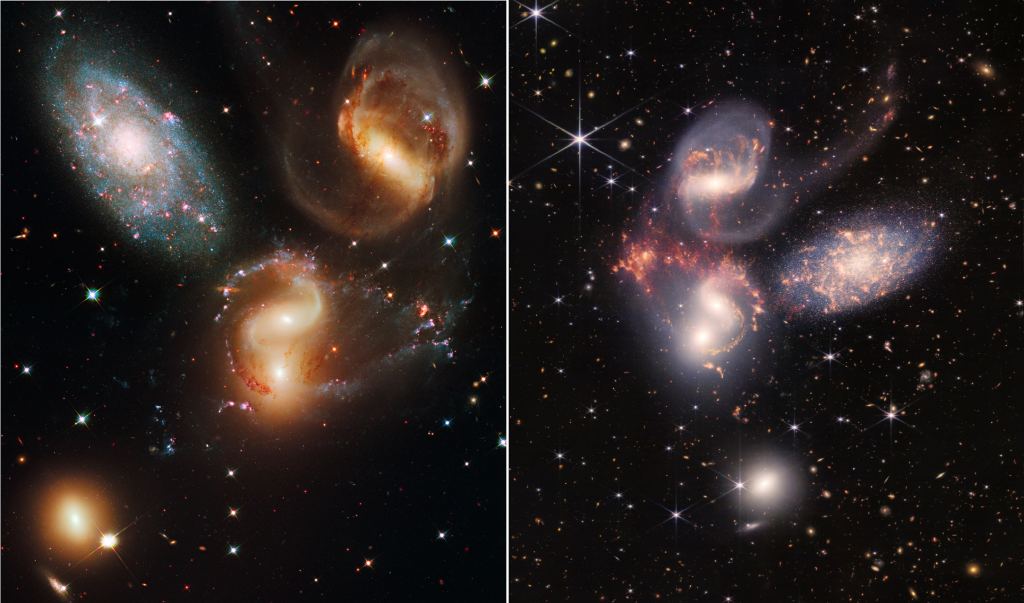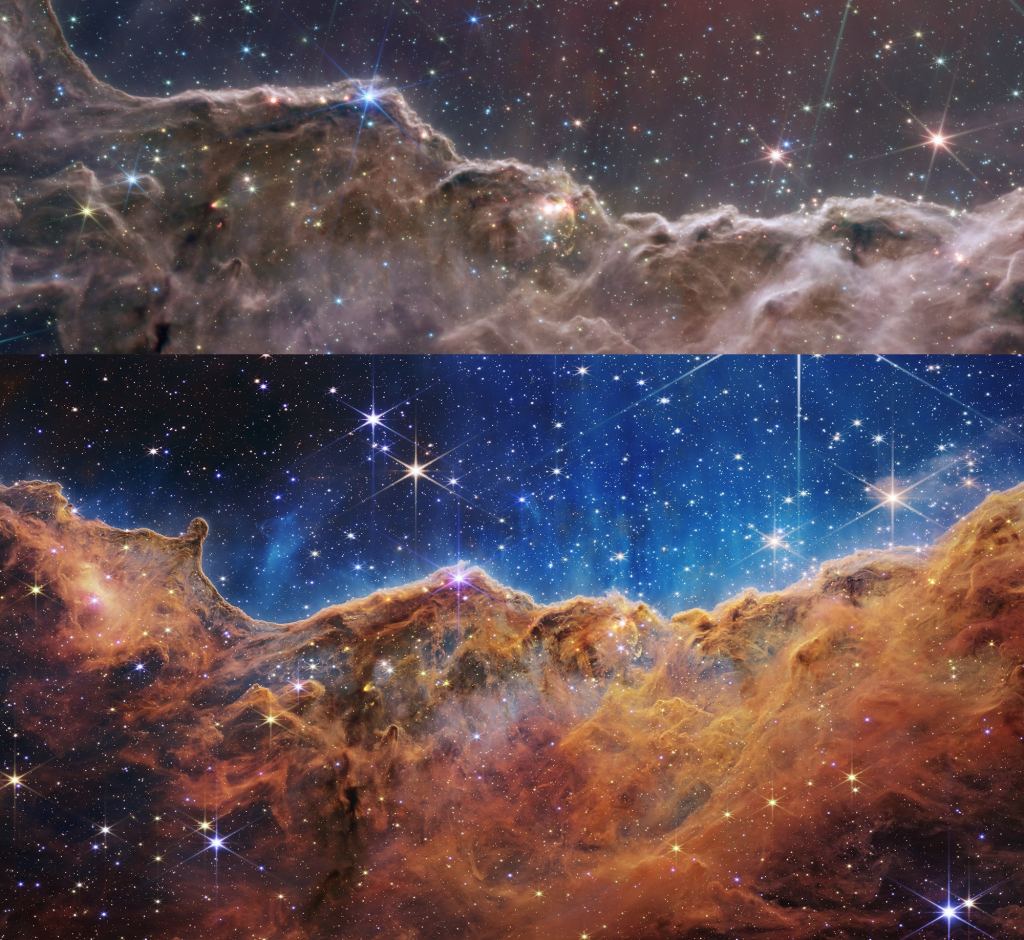On July 12th, 2022, NASA and its partner agencies released the first James Webb Space Telescope (JWST) observations to the public. These included images and spectra obtained after Webb’s commissioning phase, which included the most-detailed views of galaxy clusters, gravitational lenses, nebulae, merging galaxies, and spectra from an exoplanet’s atmosphere. Less than a month after their release, a paper titled “The JWST Early Release Observations” has been made available that describes the observations and the scientific process that went into making them.
The EROs is a set of public outreach products created to mark the end of JWST’s commissioning and the beginning of science operations. These products were chosen by the ERO Selection Committee, an international body formed in 2016 composed of members from NASA, the Canadian Space Agency (CSA), and the European Space Agency (ESA), with support provided by the Space Telescope Science Institute (STScI). The paper that describes the ERO was authored by researchers from the STScI, the Association of Universities for Research in Astronomy (AURA), and the Department of Physics & Astronomy at John Hopkins University.
As noted in a previous article (concurrent with the release), the first observations from the Webb mission included a deep field image of the SMACS J0723.3-7327 galaxy cluster and distant lensed galaxies, the merging galaxy group known as Stephan’s Quintet, the Carina Nebula (NGC 3324), the Southern Ring planetary nebula (NGC 3132), and spectra obtained from the transiting hot Jupiter WASP 96b. The ERO describes how these targets were selected, which of Webb’s instruments were used to study them, and what they revealed.
Target Selection
In the first section of the paper, the authors state how these targets were selected in 2017 by the ERO Committee based on solicitations from the American Astronomical Society (AAS) and the JWST Science Working Group (SWG). From this, the ERO Committee selected a superset of targets based on existing data, particularly color images taken by the Hubble and Spitzer Space Telescopes. These, in turn, were evaluated based on their relevance to the JWST’s four scientific themes: observations of the first galaxies that formed during the “Cosmic Dawn” period, how these galaxies have since evolved, the lifecycle of stars, and extrasolar planets.
The final targets were selected from these, with additional consideration for the major observation modes of JWST’s four science instruments. These instruments make up the Integrated Science Instrument Module (ISIM) and include:
- Near-Infrared Camera (NIRCam) provided by the University of Arizona
- Near-Infrared Spectrograph (NIRSpec) provided by ESA, with components provided by NASA/GSFC.
- Mid-Infrared Instrument (MIRI) provided by the European Consortium with the ESA and NASA Jet Propulsion Laboratory (JPL)
- Fine Guidance Sensor/Near InfraRed Imager and Slitless Spectrograph (FGS/NIRISS) provided by the CSA
“Finally, in early 2022, representatives from STScI’s Office of Public Outreach joined the ERO Production Team to contribute expertise in graphics design, science writing, and news production,” they write. “The JWST First Images and Spectra were created by Space Telescope Science Institute (STScI) staff between June 3 and July 10, 2022, from the first observation to the final delivery to NASA. In total, more than 30 people were involved in the production team, supported by the full commissioning and operations system for the JWST observatory.”
SMACS J0723.3-7327
This massive galaxy cluster is located about 4 billion light-years from Earth within the southern Volans constellation. This galaxy was observed many times by Hubble because of how it acts as a strong gravitational lens that magnifies the light of more distant, high-redshift galaxies in the background. From June 7th to 30th, the JWST conducted multi-object and wide-field slitless spectroscopy using its NIRSpec and NIRISS instruments, which were supported by multi-mode observations of the cluster and the surrounding field with NIRCam and MIRI.

According to the paper, the aim of these observations was to demonstrate the ability of JWST to rapidly image high-redshift galaxies (those that are farthest from us) at a depth rivaling the most sensitive images acquired by the Hubble Deep Fields campaign. While Hubble could capture galaxies over 13 billion light-years distant, the improved sensitivity of the JWST allowed it to see very high-redshifted galaxies and fainter, redder galaxies that contain significant dust (which obscures their light). As the authors summarize:
“The gravitationally lensed arcs both increase the richness of the background field, as well as offer a science narrative related to the use of gravitational lensing to magnify and enhance distant galaxies. The multi-object spectroscopy was intended to demonstrate emission-line signatures of star-forming galaxies, and illustrate to the public how redshifts (look-back time) can be measured to high precision by JWST. The NIRCam imaging was also used to create a catalog from which the NIRSpec MSA configuration could be constructed, following a workflow similar to that which future science programs would use.”
Stephan’s Quintet
This collection of galaxies takes its name from French astronomer Édouard Stephan, who made the first recorded observation from the Marseille Observatory in 1877. It consists of at least four individual large galaxies at an average distance of 288.9 million light-years (which appear to be actively merging). The fifth galaxy (NGC7320) is not interacting and is instead in an apparent chance alignment with the group – where they look like they are merging relative to the observer but are actually very far apart. This galaxy group was viewed multiple times between June 11th and 20th using multiple instruments – including NIRCam, MIRI, and NIRSpec.
According to the paper, these observations aimed to illustrate the energetic interactions that occur in a compact group of merging galaxies. This same group was previously imaged by Spitzer using its IR instruments, but Webb’s improved sensitivity provided images that were far more detailed. In particular, mid-infrared observations showed how Stephan’s Quintet is characterized by large-scale shock waves at the point where two of the galaxies (NGC 7318 and NGC 7319) are interfacing. Furthermore, they showed that AGC 7319 harbors a bright Seyfert 2 Active Galactic Nucleus (AGN) associated with a strong, extended radio jet emanating from its poles.

Carina Nebula
Next up, there’s the image of the “Cosmic Cliffs,” an ionized bubble formed by hot young stars near the easter edge of the star-forming Carina Nebula (NGC 3324). Located approximately 8,500 light-years from Earth in the Carina–Sagittarius Arm of the Milky Way galaxy, this feature is one of several that became iconic thanks to previous images acquired by Hubble. Once again, the JWST provided images of superior quality thanks to its advanced IR suite, which provided a more detailed view of this star-forming region.
The JWST focused on the eastern edge because it was expected to show the sharpest ionization boundary and the greatest brightness and color contrast (based on images previously provided by Spitzer). Webb observed this area twice on June 3rd with its NIRCam and three times on June 11th with its MIRI camera. The combined image captures a landscape view of the bubble in near- and mid-infrared, highlighting the contrast between the ionized (hotter) and molecular (cooler) gas. It also revealed previously-unseen newborn stars and the interaction between solar wind and gas clouds.

Southern Ring
The “Southern Ring” (NGC 3132), a young planetary nebula located about 2,000 light-years from Earth, was another target of the ERO. It contains a visual binary star consisting of a bright, main-sequence A (blue-white) star and a young white dwarf. The latter star is the source of the nebula, which it created after experiencing gravitational collapse and shedding its outer layers, and is also the ionizing source. This nebula was selected to demonstrate the JWST’s ability to observe the full lifecycle of stars. To this end, the JWST observed the nebula twice on June 3rd using its NIRCam and again on June 12th using its MIRI instrument.
These images offered a much-improved look at the Nebula (compared to a previous image obtained by Spitzer). In the NIRCam image, the main-sequence star appears brighter, while the white dwarf is partially hidden by a diffraction spike. In the MIRI image, the white dwarf appears brighter, larger, and redder due to a visual effect caused by the thick layers of dust surrounding it (which absorb heat from the star and radiate it in the mid-infrared). This way, the combined near- and mid-infrared data reveals a great deal more about the structure of the nebula and the interaction between binaries and nebular gases.
As indicated in the paper, the two images also revealed spectra, which tells us more about the composition of the nebula. “[T]he NGC3132 nebula is characterized by hydrogen recombination lines, lines from highly ionized atomic species ([Ar III], [S IV], [Ne II], and [S III]), and H2 rovibrational and rotational lines,” they wrote. “The intrinsic morphology of the nebula is likely bipolar, but viewed close to pole-on.”

WASP-96b
As noted, one of the JWST’s main objectives is the characterization of exoplanet atmospheres, which will help astronomers place tighter constraints on their habitability. Located about 1,000 lights away, this hot gas giant was selected as a target because of its mass, orbital period, and that it routinely transits its parent star relative to Earth. The purpose of these observations was to obtain a transmission spectrum of the planet that would investigate the presence of water, which was previously detected by Hubble. This was further intended to show how Webb can gather transmission spectra that will lead to the characterization of atmospheres.
During a transit that took place on June 21st, 2022, the JWST conducted Single Object Slitless Spectroscopy (SOSS) observations using its NIRISS instruments. This time-series observation mode is optimized to obtain spectra of transiting exoplanet systems that require extremely high precision and spectrophotometric stability. Instrumental stability is especially important because the spectrum of the exoplanet atmosphere must be separated from the spectrum of the host star, which is done by subtracting or dividing spectra obtained at different orbital phases. As expected, the JWST’s observations revealed a significant presence of water vapor in this exoplanet’s atmosphere.

Data Processing and Visuals
The authors also detail how the ERO observations were processed and calibrated, depending on the instrument and image. All observations were processed using the JWST Pipline5 – a Python-based library used to share Webb’s observations with the scientific, academic, and citizen scientist communities. As the authors explain, this pipeline consists of three stages, “starting from the raw uncalibrated files, through to fully calibrated exposures, and ending with full combined mosaics.”
A few steps were customized to improve the quality of the resulting images and data products. These include correcting for low-level electronic noise that the then-current version of the pipeline (version 1.5.2) didn’t account for. Similarly, many of NIRCam’s observations needed to be corrected to take into account the positions and proper motion (astrometry) of its targets. In the case of stars captured in Webb’s image field, Gaia’s Third Data Release (DR3) was used to correct for uncertainties caused by star catalog errors and roll uncertainty.
For some images, a small number of extra processing steps had to be applied to improve the quality of the final mosaics, like correcting for instrumental background noise and subtracting artifacts caused by very bright sources. The process of producing color images from the JWST data was similar to that used with other observatories (like Hubble). But as the paper notes, the capabilities of the JWST offered a wider range of color options due to its broad IR imaging capabilities:
“A key objective was to develop a striking translation of infrared colors to the visible color space, using physical and chemical tracers not available in the Hubble range. While previous infrared telescopes, such as Spitzer, made great strides in this direction, JWST offers many more filters, resulting in a much greater number of potential color combinations. The final color images represent one option out of many possible, for a wide range of different types of object, from the deep universe, where more distant or dusty galaxies naturally appear red using a range of broad-band filters, to a planetary nebula entirely dominated by non-thermal line emission from molecular, atomic, and ionized gas.”

They also describe how scaling was achieved using fitsliberator12 and PixInsight software and how noise suppression and artifact removal were accomplished through PixelClip.js image-processing algorithms. They also applied “chromatic ordering” – where color was assigned to represent different wavelengths of light – to achieve a color balance that offered the “best trade-off between science and aesthetics.” In short, this means that shorter wavelengths were prescribed a bluer color while longer wavelengths were represented in a redder color. They also used star cores in the images to perform “white balancing,” a technique that ensures the colors correspond to the proper wavelength.
All of the information regarding the ERO and the process of bringing the first JWST images to the public can be found here. Once all the necessary calibration files are available, these data sets will be made available as high-level science products (HLSPs) through the STScI’s Mikulski Archive for Space Telescopes (MAST). The ERO and subsequent images have already led to numerous breakthroughs, including more detailed views of M74, the Cartwheel Galaxy, the most distant galaxy ever observed, greatly-improved mass calculations of early galaxies, and new insight into bodies in the Solar System.
Who knows what inspiring images and scientific breakthroughs Webb will provide tomorrow, the day after that, and so on? Countless researchers, citizen scientists, and regular people worldwide are all eager to find out!
Further Reading: arXiv
The post Did you Want More Scientific Information About the First set of Images From JWST? Fill Your Boots appeared first on Universe Today.
No comments:
Post a Comment